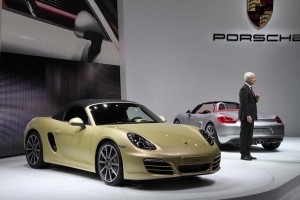The on-again/off-again Volkswagen-Porsche merger appears to have moved into the indefinite hold category, but that doesn’t mean the two German makers won’t expand their ties. In fact, VW will begin producing the all-new Porsche Boxster, later this year, alongside the Golf Cabriolet.
With Porsche facing numerous lawsuits over its failed attempt to pull off the David v Goliath acquisition of larger VW, several years ago, the potential financial liabilities have all but scuttled a merger, Porsche officials suggested during a meeting with industry analysts.
The meeting “confirmed our view that a merger of Porsche and VW is not possible,” said analyst Jochen Gehrke, of Deutsche Bank, though the smaller maker did confirm that it will continue expanding its relationship with its bigger rival.
The ties actually date back decades. In fact, Porsche and Volkswagen both trace their roots to automotive pioneer Ferdinand Porsche, who penned the original “people’s car,” the “volkswagen,” or Beetle – and his son Ferdinand Anton Ernst Porsche later went on to launch the sports car manufacturer that bears the family name. Even today Porsche is chaired by a direct heir, Wolfgang Porsche while the head of VW’s supervisory board, Ferdinand Piech, is the scion of another wing of the extended Porsche family and Wolfgang’s cousin.
There’ve often been similar familial ties when it comes to products. The Porsche 914 initially relied on a VW powertrain, for example, and the subsequent 924 was originally designed to be a Volkswagen – but was eventually given the Porsche badge.
The makers jointly developed the platform for what became the Porsche Cayenne and sibling SUVs the VW Touareg and Audi Q7.
The next stage in their alliance begins later this year with the launch of the next-generation Boxster.
Porsche ended production of the roadster, last year, at a Finnish plant run by Valmet used to meet excess demand. From 1997 to 2011, that factory had produced nearly 230,000 Boxsters and Caymans for Porsche.
The primary plant for the 2013 Boxster will be the Porsche facility in Zuffenhausen, Germany. But VW will now take on any excess demand using a factory in Osnabruck. That plant was originally designed by the independent Karmann – which itself had a long history with both VW and Porsche.
VW acquired the Karmann plant after that company went bankrupt in 2009. It is now producing the latest version of the Golf Cabriolet.
So, while the merger may be off, the functional alliance between Volkswagen and Porsche is expected to continue largely unabated.

